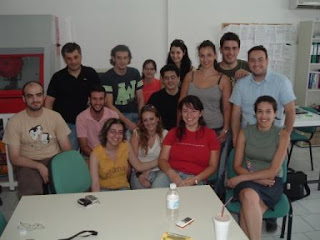On Thursday, May 31, I went to Atlanta, Georgia, and back with Kay Aaby from Montgomery County to tape interviews for an upcoming CDC satellite broadcast on
Mass Antibiotic Dispensing:
Taking the Guesswork out of POD Design. It was an honor to be invited to participate, and I appreciate the opportunity to talk about our
research on clinic planning models, which include queueing models.
The first photo is me under the lights in the studio. (They have first-class studio facilities.) I worked at CDC 20 years ago as a co-op student, so it was a bit of a homecoming, but the place has changed dramatically - almost all of the old buildings are gone, and I never went near the one remaining building where I worked.
The day was, appropriately, full of queueing. Following are items from the log I kept for the day:
6:30 am: Leave home
7:03 am: Waiting in line to check in at the AirTran ticket counter (there are only five people in front of me; over at United, the queue is overflowing the waiting area lines).
7:15 am: Waiting all through security, first for the ID check, then to get a plastic bin for my shoes and coat, then to put the stuff through the X-ray, then to get the stuff when it exits.
7:25 am: Arrive at the gate and begin waiting to board.
7:30 am: Waiting at the coffee and doughnut shop. I don't get coffee, so I have to wait only once (those getting coffee have to wait again for their coffee to be prepared).
7:36 am: Waiting in a queue to have gate agent check boarding pass, then waiting in jetway to get my seat.
8:00 am: Plane departs and lands in Atlanta at 9:30.
9:38 am: Plane stops on taxiway; pilot explains that we're waiting for an open path to our gate. (Atlanta is extremely hazy - see photo, and we can smell smoke once we're outside - must be from the wildfires.)

9:50 am: Waiting for the next train to the terminal.
10:05 am: Get cab (no line) to CDC and arrive around 10:35 to wait for our contact to appear.
11:00 am: Meet our contacts, go downstairs to do interviews (I, Kay, and Leah Matteson from New York) until 2:45.
2:50 pm: Waiting upstairs at the front desk for a cab.
3:15 pm: Depart in cab. Trip to airport takes over 35 minutes due to traffic congestion, especially at a stoplight that was blinking red.
3:58 pm: Waiting at the AirTran ticket counter (because we switched to an earlier flight and needed new boarding passes).
4:07 pm: Waiting in security (again). Exit at 4:19 and take train to Concourse C, arriving at gate at 4:30 to wait for 5:46 flight.
5:12 pm: Waiting in line to order sandwich, then waiting while sandwich is prepared.
6:00 pm: Plane is waiting on taxiway in a queue of planes that want to take off.
6:15 pm: Plane takes off and arrives at BWI at 7:40.
8:02 pm: Waiting at parking garage exit (3 cars in front of me).
8:30 pm: Home!
All together, it was a 14-hour trip comprising (roughly) 3.5 hours of interviews, 5 hours of transportation, and 5.5 hours of waiting!







